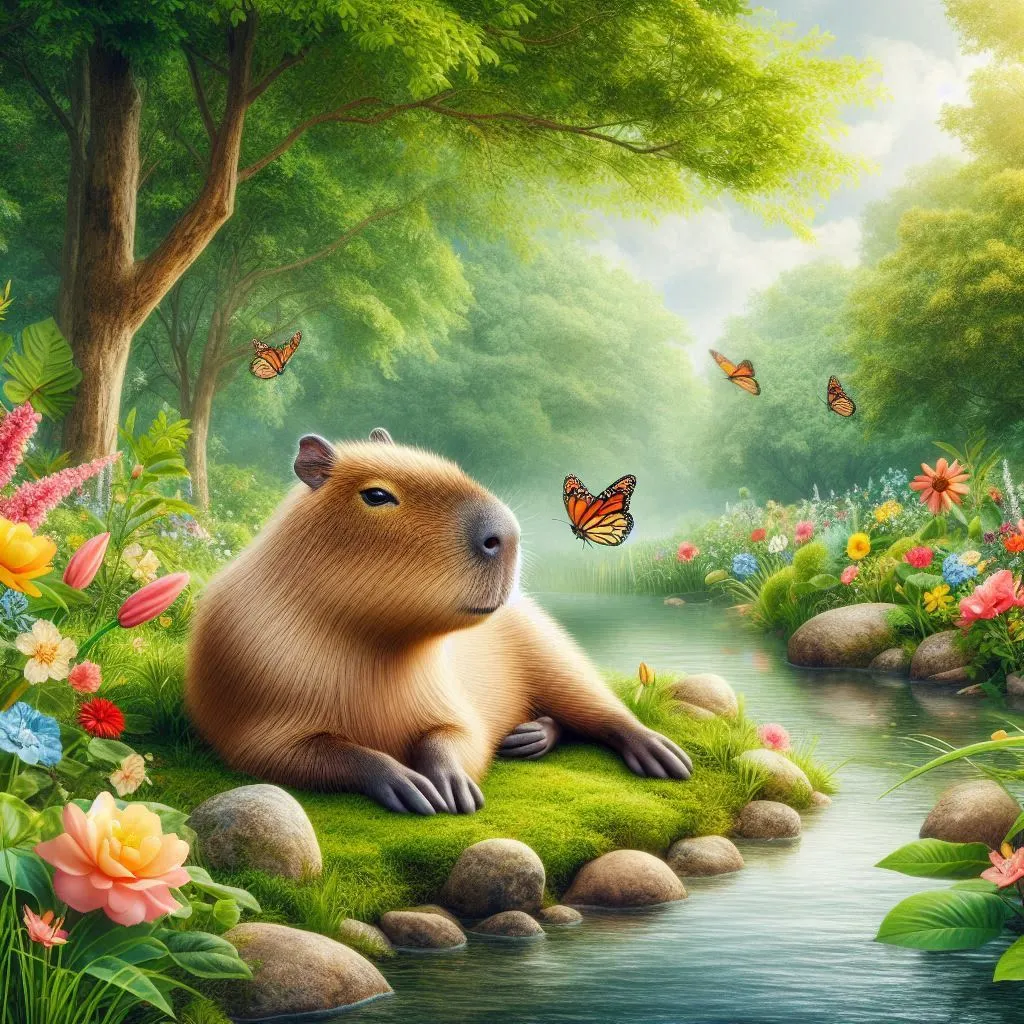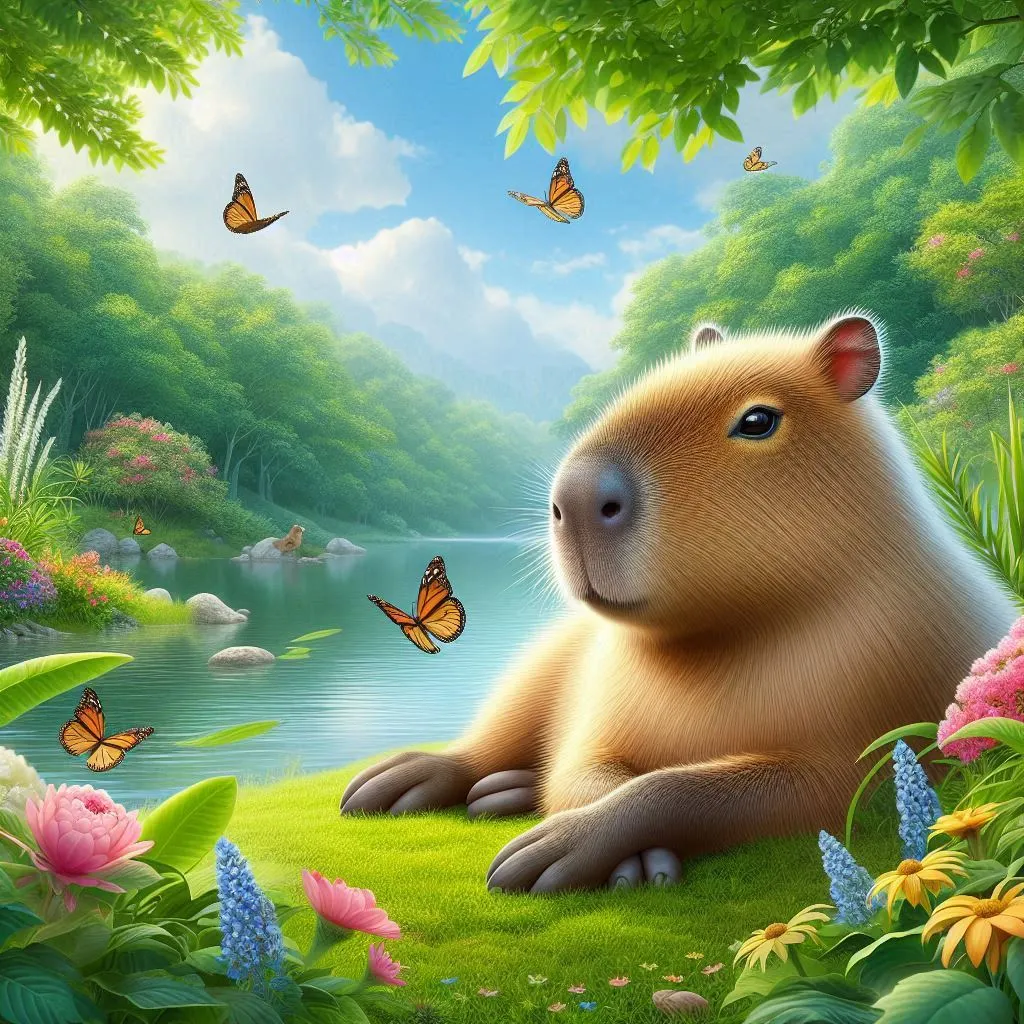- 100 Best Gifts for New Moms 2025 Ultimate Guide - 07/30/2025
- 100 Best Personalized Gifts 2025 Ultimate Guide - 07/29/2025
- 100 Best Anniversary Gifts 2025 Ultimate Guide - 07/28/2025

Table of Contents
1. Introduction to Capybaras
These South American natives are basically guinea pigs on steroids – we’re talking 100+ pounds of pure aquatic charm! Here’s the scoop:
• Family matters: They’re the oversized cousins of your pet guinea pig
• Party animals: Thrive in big groups (10-30 best friends minimum)
• Born swimmers: Built for life in and around water with webbed feet
Thinking of getting one? Heads up:
💧 Need their own swimming pool (no kiddie pools allowed)
🌿 Require specialized diets (they’re picky vegetarians)
⏳ Only for owners ready for a 10-year commitment
Perfect if you:
✓ Want the world’s most relaxed giant rodent
✓ Don’t mind a pet that’s 50% hippo, 50% teddy bear
✓ Have space for a supersized swimming companion
Quick Facts About Capybaras
| Feature | Description |
|---|---|
| Scientific Name | Hydrochoerus hydrochaeris |
| Lifespan | 8–12 years in captivity |
| Size | 3.5–4.5 feet (105–135 cm) |
| Weight | 77–146 lbs (35–66 kg) |
| Diet | Herbivore (grasses, aquatic plants, fruits) |
| Social Behavior | Highly social, thrives in groups |
| Activity Level | Semi-aquatic, active in morning/evening |
| Native Habitat | South American rainforests, wetlands, and grasslands |
Don’t let their size fool you – these giant rodents may weigh as much as a person (up to 150 lbs!), but they’ve got hearts of gold. Here’s what makes them so special:
• Big softies: Surprisingly gentle and curious despite their massive size
• South American natives: Love hanging out in forests, marshes, and grassy areas up north
• Total water babies: Need to take regular dips to stay happy and healthy
Why water matters:
💦 Their favorite escape from predators
🌿 Prime spot for snack time
❄️ Natural air conditioning on hot days
Basically, if you see a capybara, it’s either:
1) Swimming like a pro
2) Floating like a boss
3) Just generally being adorable in the water
2. Are Capybaras Good Pets?
Capybaras make unique pets but come with specific requirements that make them more suitable for experienced pet owners. They are affectionate, social, and intelligent, but they need a lot of space, interaction, and specialized care to thrive.
Characteristics of Capybaras as Pets
- Highly intelligent: Capybaras can be trained to perform basic tasks like responding to their names and using a litter box. Their high intelligence allows them to bond closely with their owners and even with other animals.
- Gentle and affectionate: They are friendly and affectionate animals. While they may initially be shy, they tend to warm up quickly and develop strong attachments to their human family members.
- Require companionship: Capybaras are extremely social and should not be kept alone. They do best when housed with at least one other capybara or similar social animal. A lonely capybara can become depressed or aggressive.
- Need access to water: Capybaras are semi-aquatic, meaning they need a constant water source to remain healthy. This could be a large pond, pool, or even a dedicated water feature in your yard.
- Litter training: While it can take time, capybaras can be litter-trained. They are clean animals by nature and will often designate a spot to urinate or defecate if provided with a proper litter area.
Capybaras are a good fit for those who are looking for a unique, affectionate companion that requires a lot of time, care, and attention. However, due to their size and specific needs, they may not be suitable for first-time pet owners.
3. Legal Considerations for Owning a Capybara
Before adopting a capybara, it is essential to check local laws and regulations. In some areas, owning a capybara is restricted or regulated, and you may need a special permit or license to keep one. Additionally, some regions prohibit exotic pet ownership altogether due to concerns about invasive species and the potential spread of diseases.
Legal Status of Capybaras in Different Countries
| Country | Legal Status |
|---|---|
| USA | Legal in some states with permits; banned in others (e.g., California, Georgia) |
| UK | Requires a special license |
| Canada | Legal in some provinces with restrictions |
| Australia | Prohibited due to biosecurity risks |
| Brazil | Legal but requires a wildlife license |
| Japan | Legal with proper permits and regulations |
In the USA, for example, some states like Texas, Florida, and Ohio allow capybara ownership with proper permits, while others, like California and Georgia, have outright bans. Be sure to confirm with local wildlife authorities or animal control offices to ensure you can legally own a capybara in your area.
4. Habitat Requirements for a Pet Capybara
Capybaras are large, semi-aquatic animals that need ample space, access to water, and the right environmental conditions to thrive. Their habitat should mimic their natural environment as closely as possible, providing them with enough room to roam and a water source to swim.
Recommended Capybara Habitat Setup
| Requirement | Description |
|---|---|
| Space | At least 250 sq. ft. per capybara for indoor space. Outdoors, a larger area is preferred—ideally a 1/4-acre yard for a pair or group. |
| Water | A deep pool, pond, or water feature is essential. The water should be kept clean and should be deep enough for the capybara to swim and cool off. |
| Shelter | A shaded, dry area where the capybara can rest and escape extreme weather conditions. This could be a hut, a shed, or a large doghouse. |
| Fencing | A strong, tall fence (at least 4–5 feet high) is necessary to prevent the capybara from escaping. Capybaras are excellent swimmers and may attempt to climb or jump over lower fences. |
| Temperature | Capybaras do best in warm climates. An ideal temperature range for them is 75–85°F (24–29°C). In cooler climates, special heating elements or indoor spaces may be required. |
| Natural Environment | Ideally, capybaras should be kept in an area with access to grass, plants, and a variety of natural features to explore and forage. They enjoy foraging for grasses and will often eat weeds and other vegetation. |
A capybara needs both land and water space, as they are natural swimmers. A small kiddie pool will not suffice, and you’ll need to provide a larger water body to give them the opportunity to cool off and display natural behaviors.
5. Capybara Diet and Nutrition
Capybaras are herbivores and require a diet that is high in fiber to support their large size and active lifestyle. Their primary food source is grasses, which makes up the majority of their diet in the wild. In captivity, it is crucial to replicate this diet with a variety of fresh vegetables, hay, and some fruits.
Capybara Diet Plan
| Food Type | Examples |
|---|---|
| Primary Diet | Fresh grasses, hay (Timothy, Bermuda), and aquatic plants. These foods should be high in fiber and low in protein. |
| Vegetables | Leafy greens such as lettuce, kale, and spinach, along with root vegetables like carrots, sweet potatoes, and zucchini. |
| Fruits | Apples, melons, and bananas (only in moderation due to sugar content). |
| Supplements | Vitamin C-rich foods like bell peppers and citrus fruits are essential to prevent scurvy, a common issue in capybaras. |
| Water | Fresh, clean water should always be available for hydration and for swimming. |
Foods to Avoid: Capybaras should not be fed processed foods, dairy, or meats. Additionally, sugary snacks, chips, or any foods high in salt should be avoided as they can lead to health problems such as obesity and kidney disease.
6. Social Needs and Behavior
Capybaras are extremely social animals. In the wild, they live in groups of 10 to 30 individuals, and their social nature continues when kept as pets. Capybaras thrive on companionship, not only from other capybaras but also from their human families and even other pets.
Key Social Behaviors
- Communication: Capybaras use various vocalizations, including whistles, purrs, and barks, to communicate with each other and with their human caretakers. These sounds are usually a sign of contentment, affection, or distress.
- Bonding: Capybaras form strong social bonds with their owners and other animals in the household. They enjoy being petted and will often seek out human interaction.
- Grooming: In groups, capybaras groom each other as a form of bonding. They will often groom their owners and other pets if they feel safe and comfortable.
- Territorial Behavior: While generally peaceful, capybaras may become territorial if they feel threatened or if there is a lack of social interaction. They need the company of at least one other capybara to avoid loneliness and anxiety.
A lonely capybara may become depressed, anxious, and even destructive. Therefore, it’s best to adopt at least two capybaras if you plan to keep them as pets.
7. Health and Veterinary Care
Capybaras require specialized veterinary care, and it’s important to find a vet who is experienced in treating exotic animals. Regular check-ups and preventative care can help keep your capybara healthy and happy.
Common Health Issues
| Health Issue | Symptoms | Prevention |
|---|---|---|
| Scurvy | Weakness, swollen joints | Provide Vitamin C-rich foods regularly |
| Overgrown Teeth | Difficulty eating or chewing | Ensure access to hay and chew toys to wear down teeth naturally |
| Skin Infections | Hair loss, redness, and inflammation | Keep the habitat clean and monitor for signs of infection |
| Obesity | Lethargy, difficulty moving, or breathing problems | Ensure a balanced diet and ample exercise opportunities |
Regular health check-ups are essential, and capybaras should be monitored for signs of parasites, dental issues, and other common health problems. Regular grooming is also recommended to prevent skin infections and matting of their fur.
8. Costs of Owning a Capybara
Capybaras can be expensive to care for, especially when considering their specialized needs. The initial cost of purchasing a capybara, setting up its habitat, and providing for its ongoing needs can add up quickly. However, the joy they bring as pets can make them well worth the investment.
Estimated Cost Breakdown
| Expense | Estimated Cost (USD) |
|---|---|
| Capybara Price | $1,500–$3,000 |
| Habitat Setup | $2,000–$5,000 |
| Monthly Food Cost | $50–$150 |
| Veterinary Care | $200–$500 annually |
Total First-Year Cost: $4,000–$8,000, with ongoing annual costs of around $1,000–$2,000 for food, medical care, and maintenance.
9. Pros and Cons of Keeping a Capybara as a Pet
Pros
✔️ Friendly, affectionate, and trainable
✔️ Highly social animals that enjoy human companionship
✔️ Great for families with space and time to devote to their care
✔️ Unique pet with an interesting and peaceful demeanor
Cons
❌ Requires significant space and access to water
❌ Expensive to maintain, especially in terms of habitat and food costs
❌ Legal restrictions in many places
❌ Must be kept in pairs or groups, as they are social animals
10. Capybara vs. Other Exotic Pets
| Feature | Capybara | Guinea Pig | Mini Pig |
|---|---|---|---|
| Size | 100–150 lbs | 2–3 lbs | 50–150 lbs |
| Social Needs | High | Medium | High |
| Housing Needs | Large outdoor space | Small cage | Large yard |
| Legal Restrictions | Many | Few | Some |

11. Frequently Asked Questions (FAQs)
Q1: Can capybaras be house-trained?
Yes, capybaras can be house-trained, although it requires patience. They can learn to use a litter box or a designated potty area.
Q2: Do capybaras bite?
Capybaras are not aggressive by nature. They rarely bite, but they may nip if startled or frightened.
Q3: How long do capybaras live?
Capybaras typically live between 8 to 12 years in captivity.
Q4: Can capybaras live alone?
Capybaras are highly social animals and should not be kept alone. They need at least one other companion, whether it be another capybara or a compatible animal.
12. Conclusion
Want a pet that’s equal parts adorable and demanding? Capybaras could be perfect – if you can handle their special lifestyle:
They absolutely need:
- A backyard that’s basically a private wetland
- Water deep enough to swim in daily
- At least one capybara companion
You’ll need to provide:
💰 Exotic vet-level funding
⏳ A solid 8-12 year commitment
📜 Legal approval (many places say no)
Ideal for:
• Seasoned exotic animal owners
• Folks with serious outdoor space
• People who enjoy explaining their unusual pet
Not ideal if:
You prefer low-maintenance pets
You live in an apartment
Your budget is tight
Reference Links
- National Geographic
- Exotic Pet Vet Guide
- World Animal Foundation
- American Veterinary Medical Association
Recommended Articles:
- How to Be Funny Ultimate 2025 Guide
- 100 Best Guess What Jokes Ultimate 2025 Guide
- What the Difference Between Jokes? 2025 In-Depth
- What Is a Homemaker? 2025 Expert-Backed Guide
- 100 Best Dad Jokes for Kids 2025 Ultimate Guide
- 100 Best Bad Dad Jokes 2025 Ultimate Guide
- 100 Best Deez Nuts Joke 2025 Ultimate Guide
- 100 Best Candice Joke 2025 In-Depth Guide
- Top 100 Best Christmas Movies 2025 In-Depth Guide
- Top 100 Best Christmas Family Games 2025
- Top 100 Best Fun Family Games 2025 In-Depth Guide
- Top 100 Best Family Games 2025 Ultimate Guide
- 100 Talk Show Hosts 2025 In-Depth Guide
- 100 Best Funny Dad Jokes 2025 In-Depth Guide
- 100 Best Funny Games 2025 In-Depth Guide
- 100 Best Funny Names 2025 In-Depth Guide
- 100 Best Good Jokes 2025 In-Depth Guide
- 100 Best Christmas Jokes 2025 🎅 In-Depth Guide
- 100 Best Corny Jokes 2025 In-Depth Guide
- 100 Best Kids Jokes 2025 In-Depth Guide
- 100 Best Knock Knock Jokes 2025 In-Depth Guide
- 100 Best Dark Jokes 2025 😈 | In-Depth & Hilarious Guide
- 100 Best Dark Humor Jokes 2025 In-Depth Guide
- 100 Attractions in the World 2025 In-Depth Guide
- Amazon Best Sellers in Clothing Shoes: Top 10 2025
- Walmart Photo Center: The Ultimate Guide 2025
- Capybara as a Pet: The Ultimate Guide 2025
- Top 100 Attractions in the World 2025
- US Female Movie Stars Top 10 2025 In-Depth Guide
- Who is the Most Handsome Man in the World?
- Top 100 Party Entertainment Ideas 2025
- 100 Best Dad Jokes That Never Get Old 2025
- US Male Movie Stars Top 10
- How to Make Slime 2025 In-Depth Guide
- YouTube History Top 10 Funny Videos 2025 In-Depth
- How to Make a Paper Airplane 2025 In-Depth Guide
- Can Dogs Eat Fruit? A Comprehensive Guide 2025
- The Funniest Dad Jokes 2025 In-Depth Guide
- 100 Funny Jokes 2025 In-Depth Guide
- 2025 100 Best Dad Jokes In-Depth Guide
- Best Dry Humor 2025 In-Depth Guide
- Calico Cat Names: 2025 Ultimate Guide
- Why Are Dogs So Cute? In-Depth Guide 2025
- Can Dogs Eat Tomatoes? A Complete Guide for Pet Owners
- What Can Dogs Eat? 2025 A Complete Guide
- Why Are Cats So Cute 2025
- Can Dogs Eat Cat Food 2025 In-Depth Guide
- Why Does My Cat Lick Me 2025
- 999 Angel Number Meaning: A Complete Guide
- 888 Angel Number Meaning: A Powerful Symbol
🎯 Don’t Miss Out — These Are Reader-Favorite Bestsellers You’ll Love Too 👇
| # | 🎁 Product | 💬 Why It Converts | 🔗 Quick Action |
|---|---|---|---|
| ✅ 1 | Exploding KittensThe Wildly Popular Card Game | 🔥 100,000+ rave reviews🤣 Fun for all ages🎉 #1 party game choice | 👉 Click to Check Price |
| 😂 2 | Funny Dad T-Shirt“You Can’t Scare Me, I Have Kids” | 👕 Viral dad gift🎂 Perfect for birthdays & Father’s Day💬 Gets people laughing instantly | 👉 See It in Action |
| 🕯️ 3 | Luxury Candle Gift SetElegant 1-Wick, Spa Fragrance | 🧘♀️ Instant relaxation🎁 Beautifully boxed for gifting💡 Affordable luxury | 👉 Treat Yourself or Gift Now |
| 🔍 4 | Tile Bluetooth TrackerFind Anything in Seconds | 🛠️ Life-saving tech🧓 Great for parents, teens, travelers📱 Works with your phone | 👉 Never Lose Anything Again |
| 📘 5 | Atomic Habits by James ClearTransform Your Daily Life | 📖 20M+ readers worldwide🔑 Simple steps, big results🎓 Top self-growth book | 👉 Read What Everyone’s Talking About |
✅ Why These Items Sell:
| 💡 Trigger | Example in Table | How It Helps Conversion |
|---|---|---|
| ✅ Social Proof | “100,000+ rave reviews” | Builds trust instantly |
| 🎯 Use Case Clarity | “Great for family game night” | Reduces decision friction |
| 🚀 Action Verbs | “Click to check price” | Encourages immediate action |
| 🔥 Urgency & Emotion | “Don’t miss out” / “Treat yourself” | Triggers impulse buying |
| 🎁 Gifting Potential | “Perfect for birthdays & holidays” | Taps into universal purchase intent |
❤️ Your Click Makes a Difference
Every purchase made through these links helps support this site and keeps great content coming — Thanks!
💬 Why Tip? It’s Not Just Money — It’s Motivation ❤️
| 😊 What You Got | 🎁 What I Get | 🔗 What You Can Do |
|---|---|---|
| ✔️ A smile or laugh | ✔️ A reason to keep creating | 👉 Buy me a coffee ☕️ |
| ✔️ Useful tips, insights, or ideas | ✔️ Proof that this content helps | 👉 Click the support button 💸 |
| ✔️ Fun, relatable content | ✔️ Motivation to go deeper & better | 👉 Leave a tip + kind feedback 🙌 |
| ✔️ Ad-free reading experience | ✔️ A little financial breathing room | 👉 $1 isn’t too little, $10 isn’t too much 🎉 |
| ✔️ A sense of connection | ✔️ The joy of being seen and supported | 👉 Let me know you’re out there 👀 |
❤️ If you made it this far, maybe that’s your sign to support? Every tip matters!



















































